UNDER THE POLE launched the CAPSULE program in 2017: 3 years of work to develop a lightweight submerged living cell with large transparent domes. It offers a 360 ° panoramic view and lets observe marine ecosystems 24 hours a day, over several days.
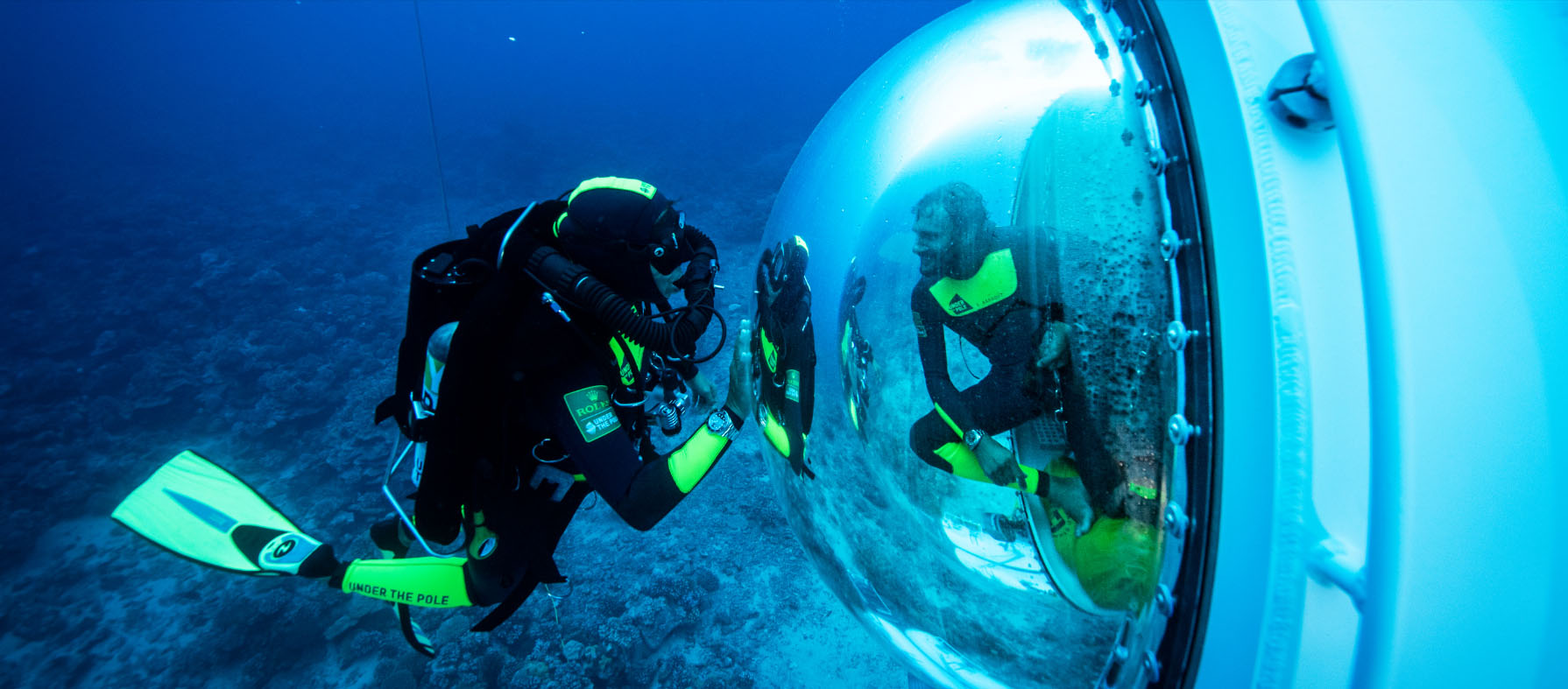
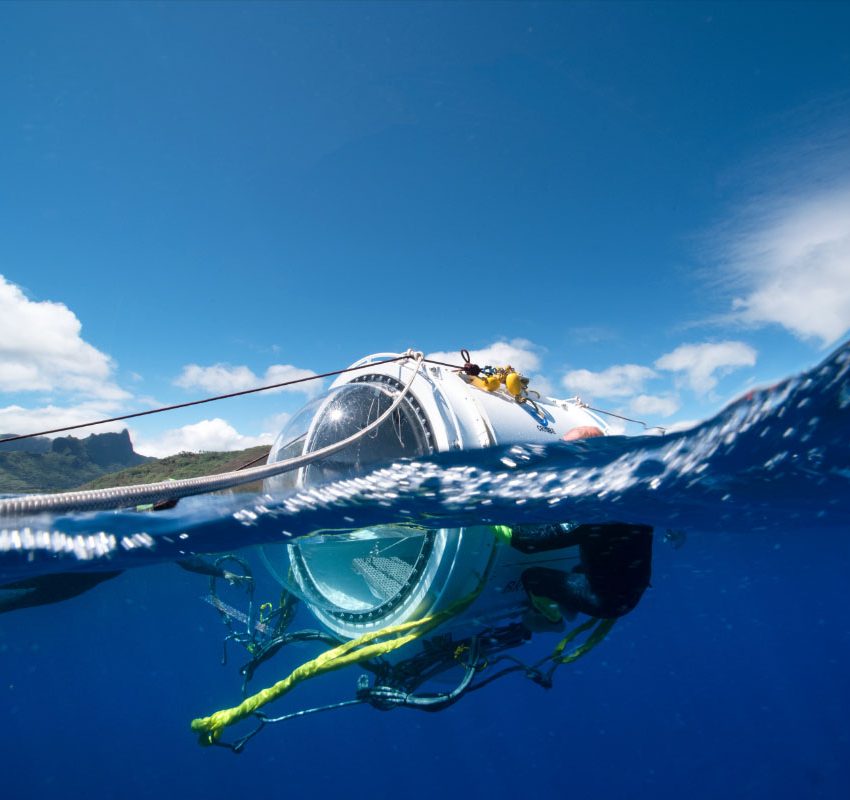
EXPERIMENTATION
AND HUMAN ADVENTURE
It is in Moorea in French Polynesia, between Opunohu and Cook's bay, on a flat area of the outer barrier reef, that the CAPSULE has found a ecosystem and divers serure site, close to the laboratory of the UNDER THE POLE scientific partner, the Island Research Center and Environmental Observatory.
OVERCOME
THE LIMITS
NEW OPPORTUNITY FOR OCEANS KNOWLEDGE
The underwater environment remains undiscovered despite the environmental emergency. Conventional dives are time limited, preventing detailed and prolonged observations of these environments. So how can we overcome these limits?
UNDER THE POLE launched the CAPSULE program to better visualize the marine atmosphere. Composed of Heliox (80% Helium + 20% Oxygen), it allows long immersions for advanced divers, offers the frequent outings flexibility, and relieves of decompression constraints.
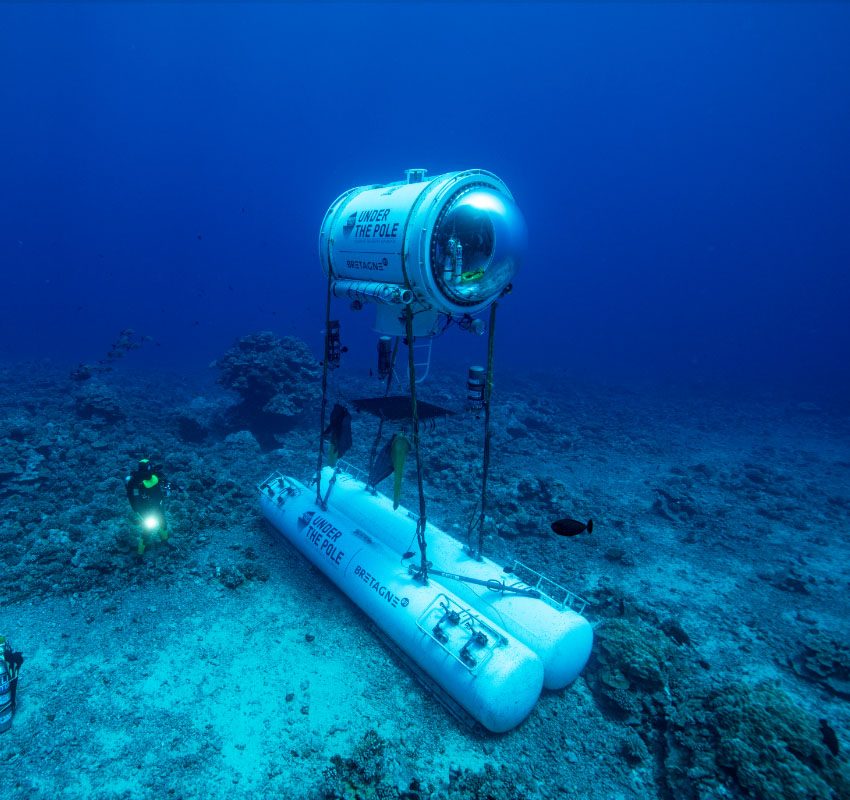
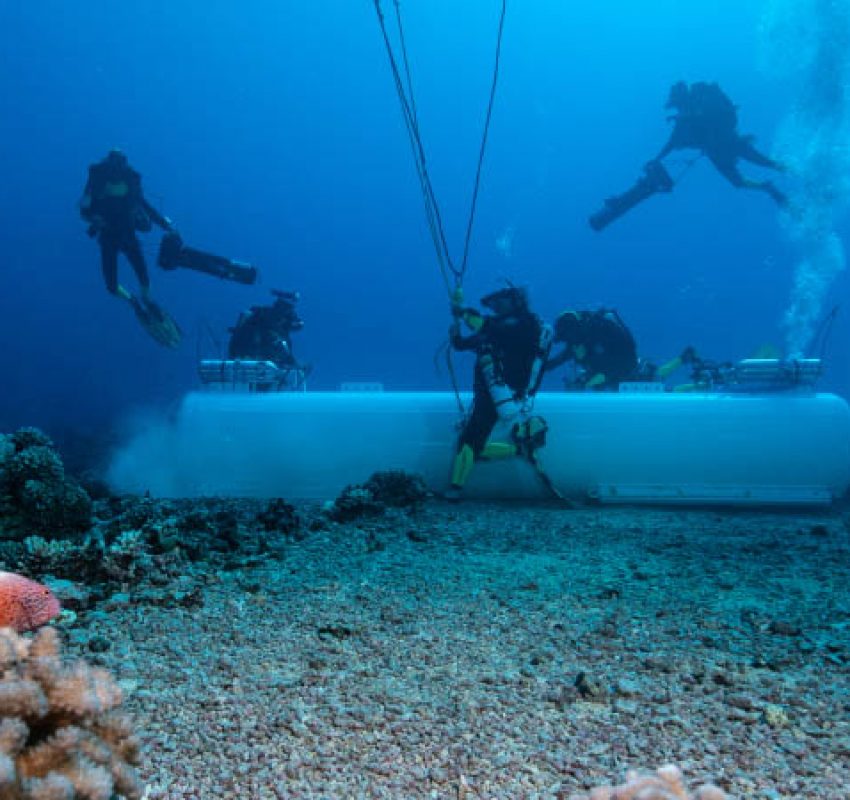
RESPOND
THE 21st CENTURY
CHALLENGES
The CAPSULE has no impact on the marine environment and is safe for reef fauna. These conditions were must-have since the start of the project: it is completely passive, immobile, without sound emissions (no noise, no sonar, no ultrasound emissions, etc.), without engie, without surface connection (no wired or pump connection) and its size is extremely small.
The CAPSULE was suspended several meters above two ballasts placed on a sandy bottom. This is a choice not to alter the reef: once the CAPSULE is brought back to the surface, there will be no trace of its installation.
The CAPSULE mission follows the Island Research Center and Environmental Observatory research on coral reefs and completes the DEEPHOPE program research. Thanks to these very long immersions, it became possible to bring together different researchers around a transversal study of the coral reefs biodiversity from the surface to the mesophotic zone, in order to preserve it.
From September to November 2019, the scientific studies mainly focused on corals and the reef inhabitants interactions, as well as on macroalgae, sea fans, molluscs and hydras.
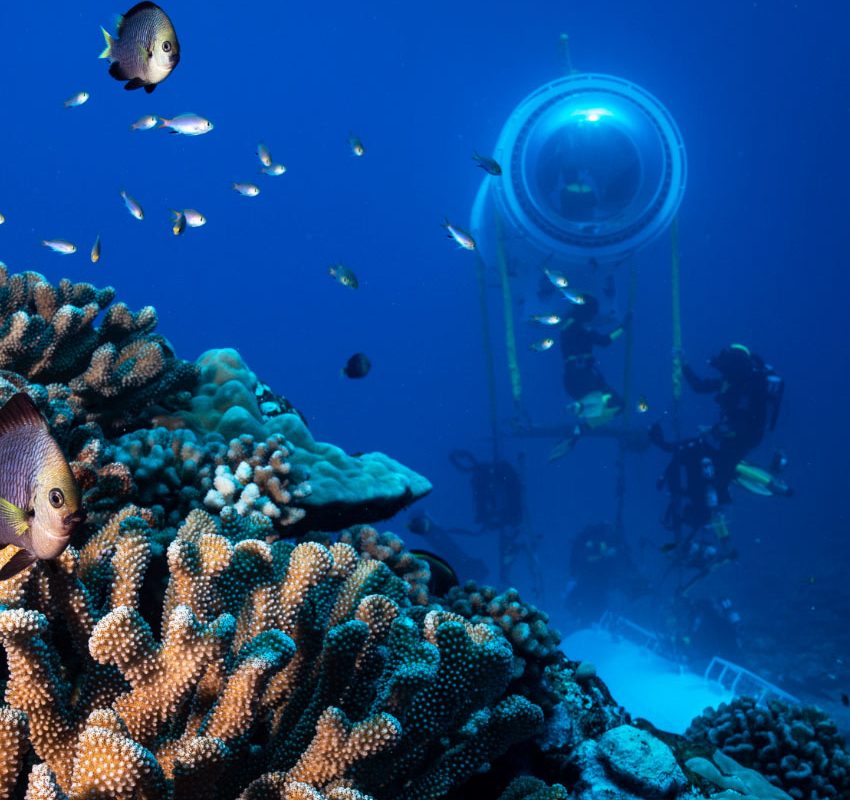
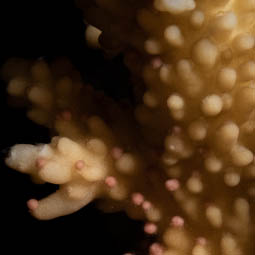
SCIENTIFIC OBJECTIVES
COORDINATION
Laetitia HÉDOUIN, French Scientific Research National Center / Island Research Center and Environmental Observatory researcher, tropical corals biology and ecology specialist.
SCIENTIFIC RESULTS
After eight consecutive nights of diving, coral spawning sighting in situ has been realized Acropora spand filmed for the first time in French Polynesia. This is the first observation the Island Research Center and Environmental Observatory researchers who until now had only carried out these observations in aquariums.

SCIENTIFIC OBJECTIVES
COORDINATION
David LECCHINI, French Scientific Research National Center / Island Research Center and Environmental Observatory researcher, tropical fish biology and ecology specialist.
SCIENTIFIC RESULTS
The two months of observation and quantification from the Capsule constitute the first continuous long-term study of the reef fish nocturnal and diurnal behaviors. The data collected in situ enrich the existing knowledge.
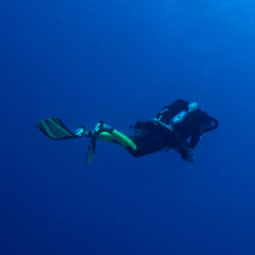
SCIENTIFIC OBJECTIVES
A scientific hyperbaric physiology study aims to validate diving protocols and advance knowledge in deep diving and saturation diving. From a medical point of view, the divers stayed several days in a confined hyperbaric humidity saturated environment, while remaining capable of carrying out the tasks related to the underwater environment study (observations from the CAPSULE, reef sampling from the habitat), and then returned safe to the surface.
SCIENTIFIC COORDINATION
Physicians and physiologists specializing in diving: Pr Jean-Éric BLATTEAU (Army Training Hospital in Sainte-Anne Toulon, Army Health Service), Emmanuel DUGRENOT (Tek Diving sas), Dr Bernard GARDETTE (former Maritime Expertise Company Scientific Director), Dr Emmanuel GOUIN (UNDER THE POLE doctor), Prof. François GUERRERO (ORPHY Laboratory, University of Western Brittany), Dr Julien HUGON (Decompression expert), Prof. Erwan L'HER (LATIM Laboratory, Brest Regional and University Hospitals).
SCIENTIFIC RESULTS
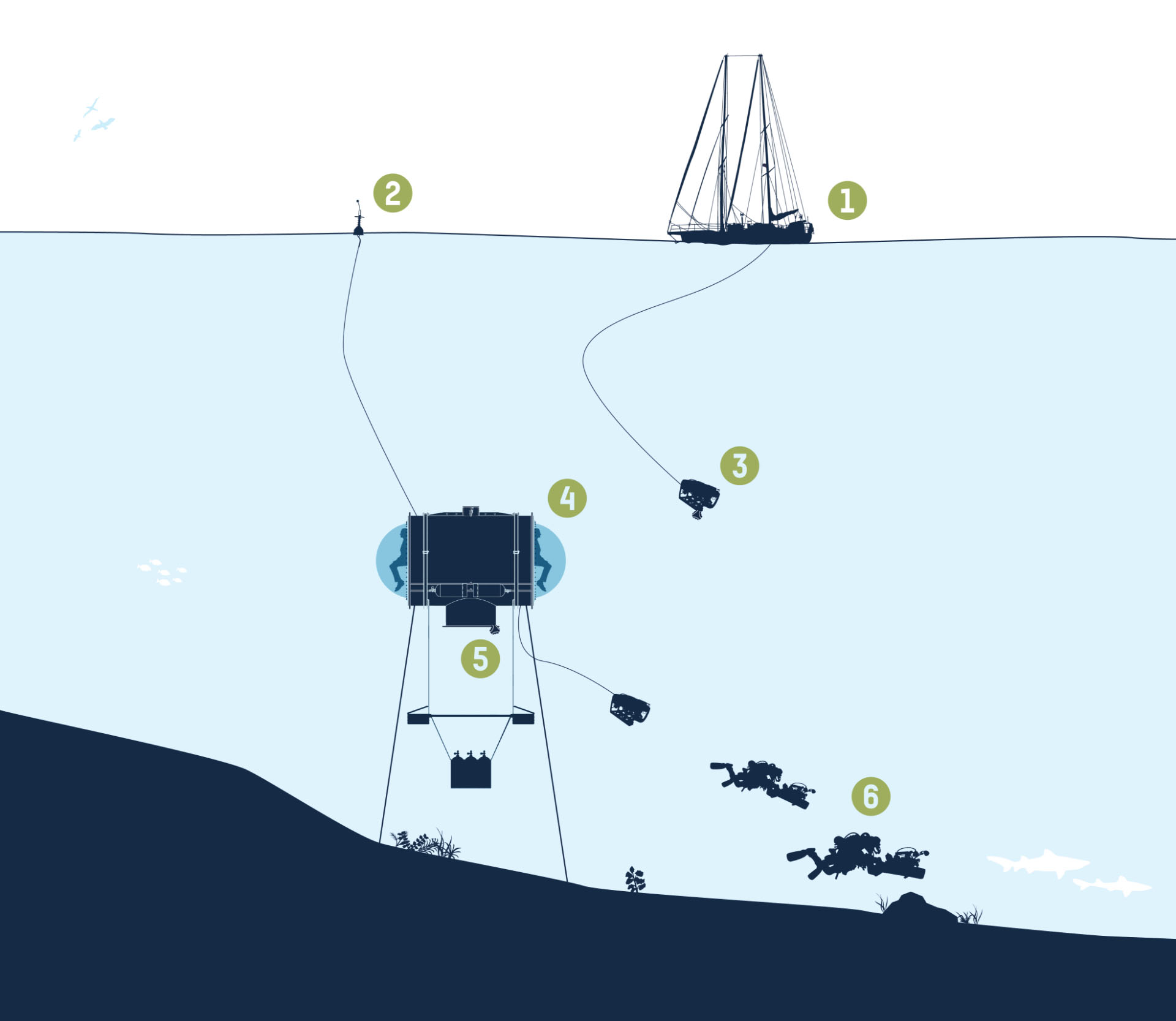
1 / THE "WHY" POLAR SCHOONER
This is the logistical and scientific basis of the expedition. It is capable of operating in all the seas of the world and can deploy the submarine capsule autonomously.
2 / SIGNALING BUOY
Equipped with a telecommunications antenna.
3 / UNDERWATER ROBOTS
It assists divers in recognizing the environment.
4 / LIGHTWEIGHT UNDERWATER HABITAT
Easy to set up between immersions, divers rest and feed without leaving the environment. More than a simple shelter, this submerged observation post makes it possible to capture everythig that is happening under the oceans.
5/ 360 ° CAMERAS
It allows the on-shore crew to follow the current dives live.
6 / EQUIPPED DIVERS
The equipment: recyclers and thrusters capable of operating down to 200 m depth.
Don't miss the latest news and previews!
Data Protection Act of 6 January 1978 : the undersigned is informed that his personal data will be collected and processed electronically by the Club. This data will be stored by the UNDER THE POLE for administrative purposes for a period of 3 years. The undersigned is informed of his right of access, communication and rectification, in case of data proven inaccuracy as well as his right to oppose the processing and / or publication of his data for legitimate reasons. To do so, simply send an email to the following address: contact@underthepole.com
At your service
Data Protection Act of 6 January 1978 : the undersigned is informed that his personal data will be collected and processed electronically by the Club. This data will be stored by the UNDER THE POLE for administrative purposes for a period of 3 years. The undersigned is informed of his right of access, communication and rectification, in case of data proven inaccuracy as well as his right to oppose the processing and / or publication of his data for legitimate reasons. To do so, simply send an email to the following address: contact@underthepole.com
Partnership
Get a file
Data Protection Act of 6 January 1978 : the undersigned is informed that his personal data will be collected and processed electronically by the Club. This data will be stored by the UNDER THE POLE for administrative purposes for a period of 3 years. The undersigned is informed of his right of access, communication and rectification, in case of data proven inaccuracy as well as his right to oppose the processing and / or publication of his data for legitimate reasons. To do so, simply send an email to the following address: contact@underthepole.com
Data Protection Act of 6 January 1978 : the undersigned is informed that his personal data will be collected and processed electronically by the Club. This data will be stored by the UNDER THE POLE for administrative purposes for a period of 3 years. The undersigned is informed of his right of access, communication and rectification, in case of data proven inaccuracy as well as his right to oppose the processing and / or publication of his data for legitimate reasons. To do so, simply send an email to the following address: contact@underthepole.com